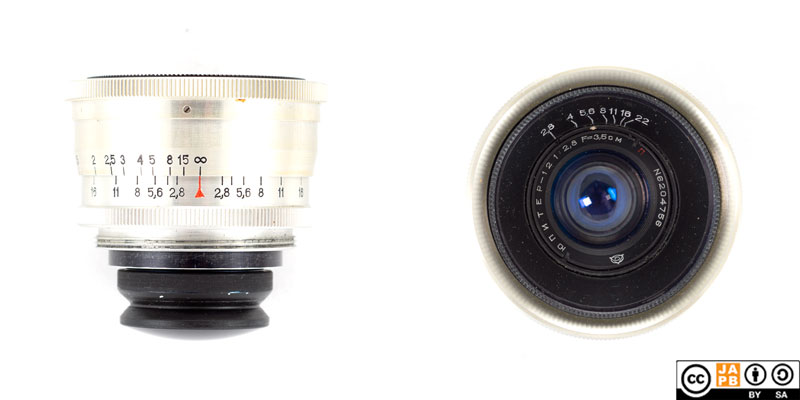Pekka Buttler, 07/2023

Specifications
The table below summarizes the lens’ key specifications (measurements based on pictured lens):
| Manufacturer: | LZOS (Lytkarinskiy Zavod Opticheskogo Stekla) | Lens name | Юпитер-12 / Jupiter-12 1:2,8 F=3,5cm |
| Focal length(s) 1 | 35 mm | Angle-of-view 2 | 63 ° |
| Maximum Aperture | f/2.8 | In Production | 1947–≈1960 (all variants) |
| Lens mounts | Leica thread mount | Other lens mounts | Contax/Kiev |
| Length 3 | 28,2 mm | Diameter 4 | 51 mm |
| Filter ring diameter | 40,5 mm | Weight | 101 grams |
| Lens element count | 6 | Lens group count | 3 |
| Aperture blades (S/R/C) 5 | 5 S | Focus throw | 110 ° |
| Minimum focusing distance | 1,0 m | Maximum magnification | 1:26,5 |
| Has manual aperture ring | YES | Has Manual focus ring | YES |
| Aperture mechanism type | Manual | Aperture click stops | None (clickless) |
Further notes:
• The Jupiter-12 is a Soviet version of the Carl Zeiss Biogon 35/2.8 (introduced 1934). While the German original was produced for the Contax rangefinder camera, the Jupiter-12 was produced for both the Soviet versions of the Contax (Kiev rangefinders) and Leica (FED & Zorki rangefinders).
• The aperture ring is clickless and fully manual.
• LZOS (a satellite of KMZ) was responsible for manufacturing LTM variants of the Jupiter-12, while Contax/Kiev versions were produced both at LZOS and Arsenal in Kiev (alongside Kiev rangefinders).
• Due to LZOS being a satellite of KMZ, LZOS Jupiter-12 lenses are sometimes referred to as ‘KMZ Jupiter-12’
• Importantly, some of the data in the table above does in no way apply to the Contax/Kiev variants: The Contax/Kiev variant does not have a focus throw nor a focusing ring (see here why)
• Special care needs to be taken as the lens has a very protruding rear lens element.
• Due to this protruding lens element, this lens is especially likely to produce partial colour casts (a.k.a. coloured corners) on such sensors that – due to a filter stack or otherwise – have a propensity for it.
History of Jupiter and other Soviet lenses
If you’re interested, I recommend you read JAPB’s article about the Soviet lens ‘business’.
History of the Biogon designs
The Biogon was designed by Ludwig Bertele in 1934 while he was working for Carl Zeiss. The first Biogon-type lens was a 35mm f/2.8, broadly semi-symmetrical design using 7 elements in 4 groups, developed for rangefinder cameras using 35 mm film. This Biogon was to be used on the Contax (the Leica already had a 35 mm lens in the 1930 Elmar).
After WW2 the family of Biogon designs for 35 mm film was expanded to include a 21 mm f/4.5 ultra wide and even a ≈12 mm rectilinear lens (that was however never mass-produced). Simultaneously, the family of Biogon-inspired designs were also used on larger formats – both medium format and especially large format.
Importantly, while Biogon designs for 35 mm film can be characterised primarily as semi-symmetrical or nearly symmetrical, most implementations of the original Biogon design on large format (whether by Schneider, Rodenstock, Nikkor, others) are fully symmetrical.
The Biogon design relies on a short distance between the rearmost lens element surface and the film/sensor-plane, and was therefore never suitable for SLRs. Even so, some such lenses were offered, but they necessitated mirror lock-up and a separate viewfinder. After the introduction of the retrofocus design (≈1950), Biogon-type lenses became practically extinct on SLRs, but remained in use on rangefinder cameras (and large format).
Versions
Besides two significantly different versions for the two rangefinder mounts, there are also several cosmetic and ergonomic iterations. There are also both silver and black versions.
Adapting
This chapter will discuss adapting the Leica Thread mount version of the Jupiter-12. If you’re interest in adapting a Contax/Kiev version, see the JAPB article on the Contax/Kiev mount.
To use this lens natively, you will need a Leica thread mount film body. This means either a Leica body from before the 1954 introduction of the Leica M-mount, a Soviet Leica (Zorki or FED) or one of the more modern Japanese LTM rangefinders. You can also use this lens on any Leica M mount body using the LTM-Leica M adapter ring.
Thanks to being a fully manual lens (manual aperture, manual focus), the lens can be adapted to all mirrorless cameras using a suitable adapter. Moreover, LTM lenses are so uncomplicated that a simple ‘dumb adapter’ will do the job perfectly. However, due to LTM mount’s relatively short flange focal distance, special adapters (helicoid adapters, tilt/shift adapters, speed boosters) are not an option.
Due to the short flange focal distance used by LTM cameras, there is no meaningful way to adapt this lens to any SLR or dSLR.
Footnotes
- Focal length is (unless stated otherwise) given in absolute terms, and not in Full-frame equivalent. For an understanding of whether the lens is wide/tele, see ‘Angle-of-view’. ↩︎
- Picture angle is given in degrees (based on manufacturers’ specs) and concerns the diagonal picture angle. Rule of thumb:
> 90 ° ==> Ultra-wide-angle
70–90 ° ==> Wide-angle
50–70 ° ==> Moderate wide-angle
40–50 ° ==> ‘Standard’ or ‘normal’ lens
20–40 ° ==> Short tele lens
10-20 ° ==> Tele lens
5-10 ° ==> Long tele lens
< 5 ° ==> Ultra-tele lens ↩︎ - Length is given from the mount flange to the front of lens at infinity. ↩︎
- Diameter excludes protrusions such as rabbit ears or stop-down levers. ↩︎
- S=straight; R=rounded; C=(almost)circular at all apertures. ↩︎